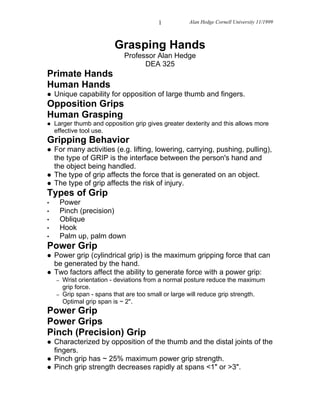Contenu connexe
Plus de Clean Agent Sdn Bhd
Plus de Clean Agent Sdn Bhd (20)
Grips
- 1. 1 © Alan Hedge Cornell University 11/1999
Grasping Hands
Professor Alan Hedge
DEA 325
Primate Hands
Human Hands
l Unique capability for opposition of large thumb and fingers.
Opposition Grips
Human Grasping
l Larger thumb and opposition grip gives greater dexterity and this allows more
effective tool use.
Gripping Behavior
l For many activities (e.g. lifting, lowering, carrying, pushing, pulling),
the type of GRIP is the interface between the person's hand and
the object being handled.
l The type of grip affects the force that is generated on an object.
l The type of grip affects the risk of injury.
Types of Grip
• Power
• Pinch (precision)
• Oblique
• Hook
• Palm up, palm down
Power Grip
l Power grip (cylindrical grip) is the maximum gripping force that can
be generated by the hand.
l Two factors affect the ability to generate force with a power grip:
– Wrist orientation - deviations from a normal posture reduce the maximum
grip force.
– Grip span - spans that are too small or large will reduce grip strength.
Optimal grip span is ~ 2".
Power Grip
Power Grips
Pinch (Precision) Grip
l Characterized by opposition of the thumb and the distal joints of the
fingers.
l Pinch grip has ~ 25% maximum power grip strength.
l Pinch grip strength decreases rapidly at spans <1" or >3".
- 2. 2 © Alan Hedge Cornell University 11/1999
l Two types of grip:
– Internal - tool handle is internal to the hand e.g. knife
– External - tool handle external to hand e.g. pen.
External Pinch Grip
l Tool handle is external to hand e.g. pen.
Internal Pinch Grip
Pinch (Precision) Grip
Precision grip
l External and internal precision grips.
Pinch Grip
l Lateral pinch grip - usually submaximal in strength because of
inappropriate grip span.
Oblique Grip
l Variant of power grip.
l Grip across a rectangular surface.
l ~65% power grip strength
l Strongly affected by grip span.
Oblique Grip: Shape
Oblique Grip: Size
Hook Grip
l Flat hand, curled fingers, thumb as stabilizer, fingers support load.
l ~strength of power grip for 2" span.
l Narrow or wide handles, or poor contours decrease grip strength. Load may
exceed 22 lbs/inch maximum skin pressure.
Palm-up and Palm-down Grips
l Palm-up - used for carrying objects.
l Palm-down - weaker grip,
Palm-up Grip
l Grip strength depends on arm strength.
l Difficult to perform when the height of the object being lifted
exceeds elbow height (~35" above floor level).
l Grip strength depends on grip span.
Lid Opening/Closing
l Ability to open or close a lid partly depends on the design of the
lid.
- 3. 3 © Alan Hedge Cornell University 11/1999
l A smaller lid that allows the fingers to curl around it transmits more
of the muscle force directly to the lid.
l A large lid reduces the ability of the hand to grasp and open/close
it.
l Hand tools (jar openers) can be used.
Pushing and Pulling
Approx. 20% of overexertion injuries are associated with
pushing/pulling work (NIOSH)
Horizontal Pushing/Pulling
l Horizontal pushing/pulling is affected by:
– Body weight
– Height of force application
– Distance of force application from body
– Amount of trunk flexion/extension
– Frictional coefficient of the floor
– Frictional coefficient of shoes
– Distance moved/duration of force application
– Availability of support structures (e.g. start blocks)
– Posture (standing, sitting, kneeling, crawling)
l Pushing is better than pulling.
Vertical Pushing/Pulling
l Vertical pushing/pulling is affected by:
– Body weight (for pulling)
– Grip strength
– Height of force application
§ Upward pulls above 10" (~25 cm) are the strongest because leg and trunk muscles can
be used.
§ Downward pulls above head level are strongest because body weight can be used.
– Posture - downward pulls from seated position are ~85% standing position.
Other Pushing/Pulling Actions
l Transverse Pushing/Pulling - across the front of the body uses the
weaker shoulder muscles. At full arm extension maximum force is ~
50% of that with horizontal pushing/pulling.
l Asymmetric Pushing/Pulling – one arm used to push/pull object or
move this across the midline of the body.
Optimal Pushing/Pulling Dimensions
l Push/pull height = 91 - 114 cm
l High traction floor = 30% more push/pull force than low traction
floor.
l Leg distances from load:
- 4. 4 © Alan Hedge Cornell University 11/1999
– Pushing = 165 cm min.
– Pulling = 40 cm max.
Palm-down Grips
l Primarily used in precision activities.
l With palm down the arms are suboptimally positioned.
l Poor grip once the load weight exceeds 1 lb. (0.5 Kg).
l Grip strength affected by grip span.

